
Leptospermum petersonii, commonly known as lemon-scented teatree, is a species of shrub or small tree that is endemic to eastern Australia. It has thin, fibrous or flaky bark, often strongly-scented elliptic to lance-shaped leaves, white flowers and fruit that are retained for several years. It is commonly grown as an ornamental and is regarded as a minor environmental weed in some areas.

Pimelea humilis, also known as common riceflower or dwarf riceflower, is a species of flowering plant in the family Thymelaeaceae and is endemic to south-eastern Australia. It is an erect or scrambling shrub with hairy stems, elliptic to lance-shaped leaves and heads of 12 to 52 of creamy-white, bisexual or female flowers.

Pimelea flava is a species of flowering plant in the family Thymelaeaceae and is endemic to south-eastern Australia. It is a shrub with narrowly elliptic to egg-shaped leaves arranged in opposite pairs, and compact clusters of 9 or more flowers with 2 or 4 elliptic to circular involucral bracts at the base. The flowers and bracts are white or yellow, depending on subspecies.

Pimelea alpina, the alpine rice-flower, is a species of flowering plant in the family Thymelaeaceae and is endemic to south-eastern continental Australia. It is an erect, prostrate or spreading shrub or undershrub with narrowly elliptic leaves crowded at the ends of branches and heads of pinkish red or white flowers.

Pimelea hewardiana, commonly known as forked rice-flower, is a species of flowering plant in the family Thymelaeaceae and is endemic to south-eastern continental Australia. It is a shrub with narrowly elliptic leaves and head-like clusters of 7 to 34 unisexual yellow flowers.

Pimelea serpyllifolia, commonly known as thyme riceflower, is a species of flowering plant in the family Thymelaeaceae and is endemic to southern Australia. It is an erect shrub with narrowly elliptic to spatula-shaped leaves, and compact heads of 4 to 12 yellow, yellowish-green or white flowers surrounded by 2 or 4 leaf-like involucral bracts. Male and female flowers are borne on separate plants.

Pimelea ligustrina is a species of flowering plant in the family Thymelaeaceae, and is endemic to south-eastern Australia. It is a shrub with lance-shaped or narrowly elliptic leaves arranged in opposite pairs, and clusters of creamy-white, white or pinkish flowers usually surrounded by 4 or 8, greenish to reddish brown involucral bracts.

Cassinia subtropica, commonly known as bushy rosemary, is a species of flowering plant in the family Asteraceae and is endemic to north-eastern Australia. It is shrub with woolly-hairy stems, lance-shaped to egg-shaped leaves and panicles of flower heads.

Pimelea glauca, commonly known as smooth riceflower, is a species of flowering plant in the family Thymelaeaceae and is endemic to eastern Australia. It has elliptic to more or less lance-shaped or linear leaves and creamy-white flowers arranged in heads of seven or more on the ends of the stems, with four lance-shaped to egg-shaped bracts at the base of the inflorescence.
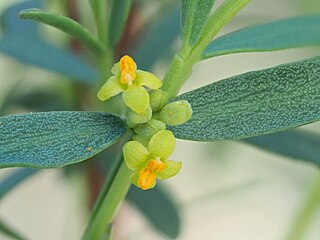
Pimelea pauciflora, commonly known as poison rice-flower, is a species of shrub in the family Thymelaeaceae. It has small yellow-lime flowers and green, smooth fleshy leaves, and is endemic to Eastern Australia.
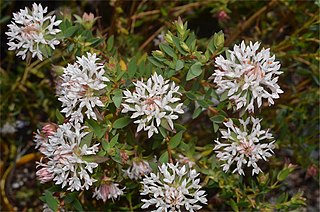
Pimelea sylvestris is a species of flowering plant in the family Thymelaeaceae and is endemic to the south-west of Western Australia. It is an erect shrub with narrowly elliptic to elliptic leaves arranged in opposite pairs, and compact heads of white or pink flowers surrounded by 2 or 4 pairs of narrowly egg-shaped involucral bracts.
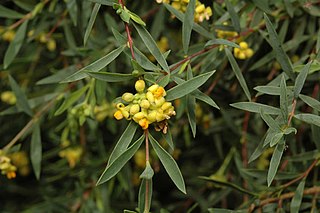
Pimelea neoanglica, commonly known as poison pimelea or scanty riceflower, is a species of flowering plant in the family Thymelaeaceae and is endemic to inland areas of eastern Australia. It is an erect, dioecious shrub with narrowly elliptic leaves and heads of greenish-yellow flowers.
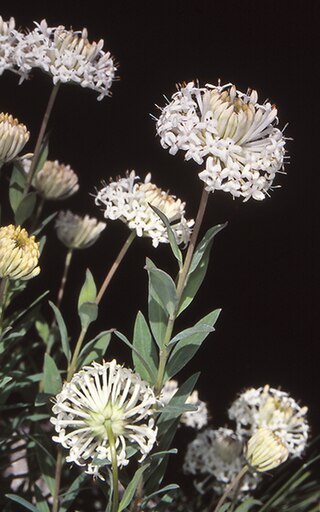
Pimelea treyvaudii, commonly known as grey rice-flower, is a species of shrub in the family Thymelaeaceae. It has white flowers in spherical heads at the end of branches and is endemic to eastern Australia.

Pimelea curviflora, also known as curved rice-flower, is a shrub in the family Thymelaeaceae and is endemic to Australia. It is a small, hairy shrub with greenish-yellow or red tubular flowers.

Pimelea venosa, commonly known as Bolivia Hill rice-flower, is a flowering plant in the family Thymelaeaceae and is endemic to a restricted area of New South Wales. It is an erect shrub with densely long-hairy stems and leaves, elliptic to lance-shaped leaves and small groups of white flowers.
Pimelea biflora, commonly known as matted rice-flower, is a species of flowering plant in the family Thymelaeaceae and is endemic to south-eastern continental Australia. It is a prostrate, mat-forming shrub with elliptic leaves and dark red flowers always arranged in pairs on the ends of branches.

Pimelea bracteata, is a species of flowering plant in the family Thymelaeaceae and is endemic to the south-west of New South Wales. It is a shrub with narrowly egg-shaped to elliptic leaves and pendulous, pale green heads of pale yellow flowers.
Pimelea drummondii is a species of flowering plant in the family Thymelaeaceae and is endemic to near-coastal areas of southern Western Australia. It is an erect, slender shrub with narrowly elliptic or elliptic leaves arranged in opposite pairs, and white or cream-coloured flowers surrounded by 3 or 4 pairs of pale green to yellowish involucral bracts.
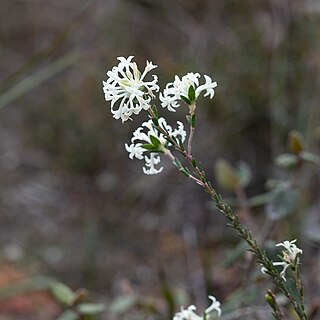
Pimelea phylicoides, commonly known as heath rice-flower, is a species of flowering plant in the family Thymelaeaceae and is endemic to southern continental Australia. It is an erect shrub with densely hairy young stems, narrowly egg-shaped to elliptic leaves, and heads of white flowers surrounded by 3 to 6 involucral bracts.

Pimelea stricta, commonly known as gaunt rice-flower, is a species of flowering plant in the family Thymelaeaceae and is endemic to south-eastern continental Australia. It is an erect shrub with narrowly elliptic or linear leaves, and compact heads of densely hairy, creamy-white to yellow flowers surrounded by 4 egg-shaped involucral bracts.


















